1.7: Act - Lead Generation and Lead Nurturing
- Page ID
- 89456
- Understand what is a lead, and how to generate, score, and nurture leads.
In this chapter, we cover the basics of lead generation and lead nurturing activities. We define what is a lead and lead stages, present a few ways to generate leads and different types of opt-ins, explain how to score leads, and discuss email marketing.
ACT
InterAct is about encouraging positive interactions on a website and social media. Positive interactions facilitate the generation of leads, which leads to acquiring customers. The two objectives at the Act stage are thus to (1) encourage positive interactions and (2) generate leads. The kind of goals we can set up for consumers have to do with these two objectives. For encouraging positive interactions, we can set up goals such as spending a certain amount of time on our website or viewing a certain number of pages. When consumers achieve these goals, we can assume we are answering this first objective. For generating leads, the kinds of goals we can set up for consumers are to register as a member or sign up for a newsletter. Again, when consumers achieve these goals, we end up achieving our objectives, i.e., acquiring leads. The KPIs to measure these goals would then be time spent on site, page views, number of members and newsletter subscribers (increase quarter-over-quarter), cost per lead, and percentage of visitors converted to leads.
Leads and Lead Generation
The grand majority of visitors to your website, some say up to 96%, will not buy anything. Given all the resources that go into bringing visitors, from writing content to publishing ads, simply trying to get visitors to a website without having a strategy of what to do once they get on there will lead to many missed opportunities.
In order to address this conundrum, digital marketers have turned to lead generation to answer the question: How do we turn a visitor into a potential customer?
Marketo defines lead generation as “the marketing process of stimulating and capturing interest in a product or service for the purpose of developing sales pipeline.” During lead generation, our goal is to gather visitors’ personal information so that we can start to market to them personally in the future and to identify whether or not we want to market to them. Not all visitors that we gather information on is worth marketing to.
A lead is (1) a qualified potential buyer (2) who shows some level of interest in purchasing a firm’s product or service. Note that this definition has two components. First, the visitor who provided their information is a qualified potential buyer. This means that they could eventually purchase our product. Of all visitors on a website, this is often not the case.
Take, for example, this lead generation activity by Ferrari, which is quite common in the automobile industry, a car configurator. During car configuration, visitors are invited to build their own car based on a car model, for example choosing between options, such as interior and exterior colors, engine, wheels, and so on. At the end of the configuration, the visitor is asked to create an account or fill out a short form and provide their email address to receive more information about this model or save the configuration. Doing so indicates to the firm that the consumer is potentially interested in this vehicle.
But are all visitors who build their own Ferrari potential Ferrari customers? Probably not.
Car configurators are probably used by many consumers who either have no interest in buying the car and are doing this for fun or, in the case of Ferrari, who have an interest in buying the car but do not correspond to the Ferrari customer (e.g., they lack the financial resources to buy a Ferrari). These visitors are not qualified. A qualified lead is a lead that has been deemed likely to become a customer. Firms qualify leads through lead scoring, which we are going to discuss a bit further.
Second, the visitor who provide their email address also needs to be interested in becoming a buyer. Since many lead generation activities provide, for example, hard to access information such as market reports of extensive guides on topics, it often happens that visitors will provide their email address without wanting to become a customer. They do so because they want to have access to the gated content or feature of a website. Lead scoring also helps differentiate between these two types of potential leads.
Hence, a lead is a visitor that is interested in a company and that the company is also interested in.
In the process of becoming a customer, a visitor will thus go through different stages, from visitor to lead to qualified lead to customer (an alternative to this model that you might come across is lead, prospect, and opportunity). Two types of qualification exist: marketing qualified lead (MQL) and sales qualified lead (SQL). Marketing qualified leads are viable leads that should be marketed to. In other words, they are visitors who gave a firm their email address that the firm has established could be potential customers. They are visitors that the firm is interested in. A sales qualified lead is a lead that is sales-ready. In other words, it is a lead that is moving close to the purchase stage. This is important because it gives an indication of what kind of marketing activities should be conducted with these leads. As we have seen, we talk differently to consumers who are at the awareness, active-evaluation, or purchase stage. Knowing which is the stage that consumers are in is highly useful to create the right marketing message.
How do You Get Leads?
There exist many, many ways to get leads. Generally speaking, any marketing activity that leads consumers to give a firm a piece of personal information qualifies as a lead generation opportunity. A non-exhaustive list is provided below:
- Content with lead magnet, such as a whitepaper, ebook, checklist, demo, course, presentation, tools, webinars, etc.
- Online contests, giveaways, etc.
- Lead generation on social media, either through dedicated options such as lead generation ads on Facebook or Instagram or by redirecting users to a lead generation landing page
- Combined with traditional marketing initiatives
- Collect emails at trade shows
- URLs or QR on direct mailing campaigns that direct to lead generation landing page
- Collect emails at a showroom
- Opt-ins everywhere: on scroll down, in the footer, or mid-way through blog posts
You can find a few more ideas here and here, and Hubspot lead generation guide here.
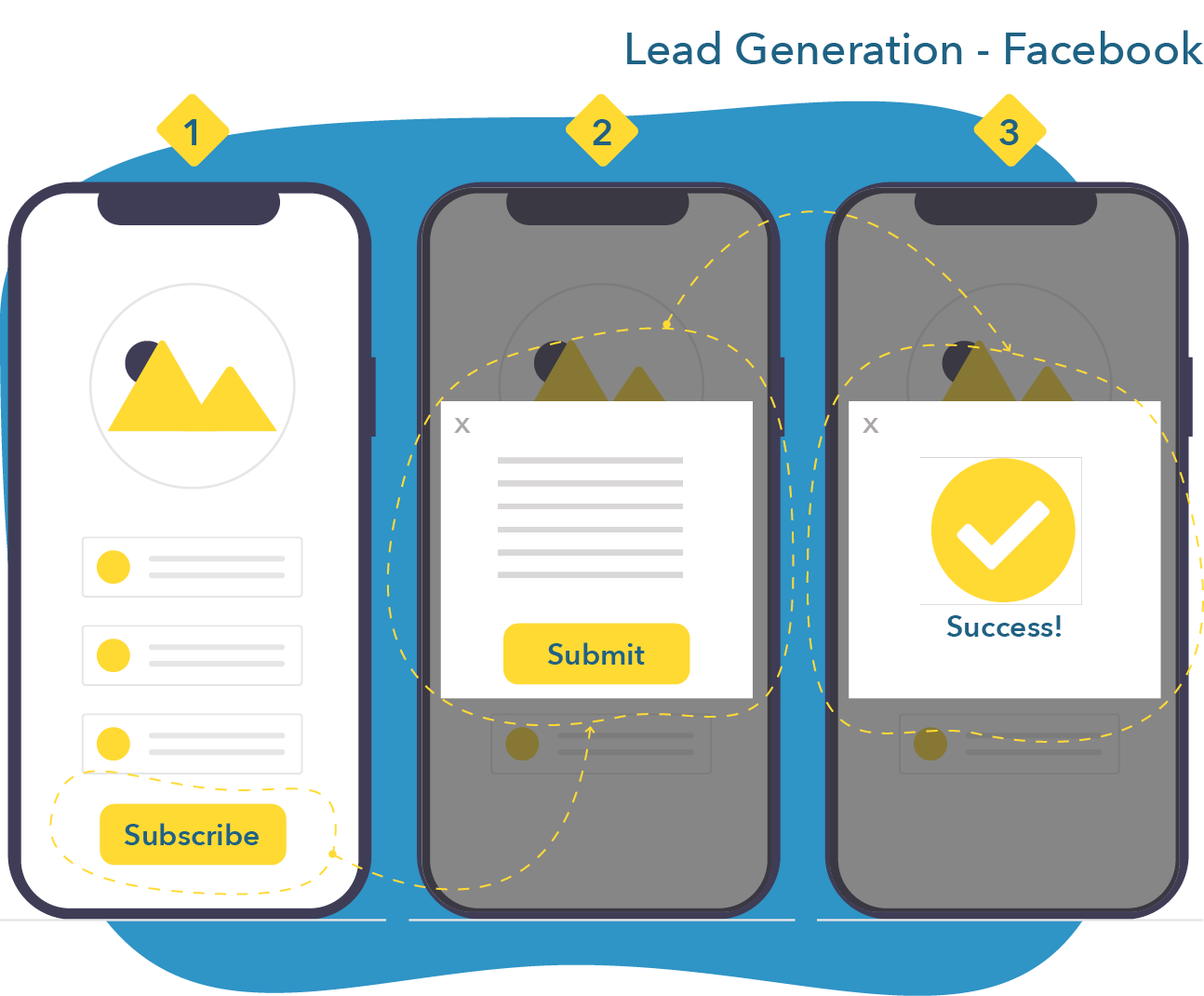
Lead generation is typically associated with lead forms. Lead forms are web forms that allow firms to capture consumers’ email addresses and, sometimes, other information. They are a great tool to build a mailing list and when correctly done, help scoring leads. We turn our attention to lead scoring later on in this chapter.
Designing lead forms, and most importantly, how many form fields you decide to use is a balancing act. It is generally argued that consumers take less than 10 seconds to decide whether or not to give their email address to a firm. There is, though, a trade-off between collecting many email addresses and collecting email addresses from qualified leads.
Take the following study from Marketo (see figure below), which found that moving from 5 to 7 to 9 form fields diminished the conversion rate (in this case, the rate of visitors that gave their email address and became a lead) from 13.4% to 12% to 10%, and increased the cost per lead from $31.24 to $34.94 to $41.90. Clearly, choosing how many form fields play an important role in pricing and devising lead generation campaigns. (Note: The cost per lead increases because it costs a certain amount of money to run the ads associated with this lead generation campaign. Hence, the lower the conversion rate, the higher the cost per lead).
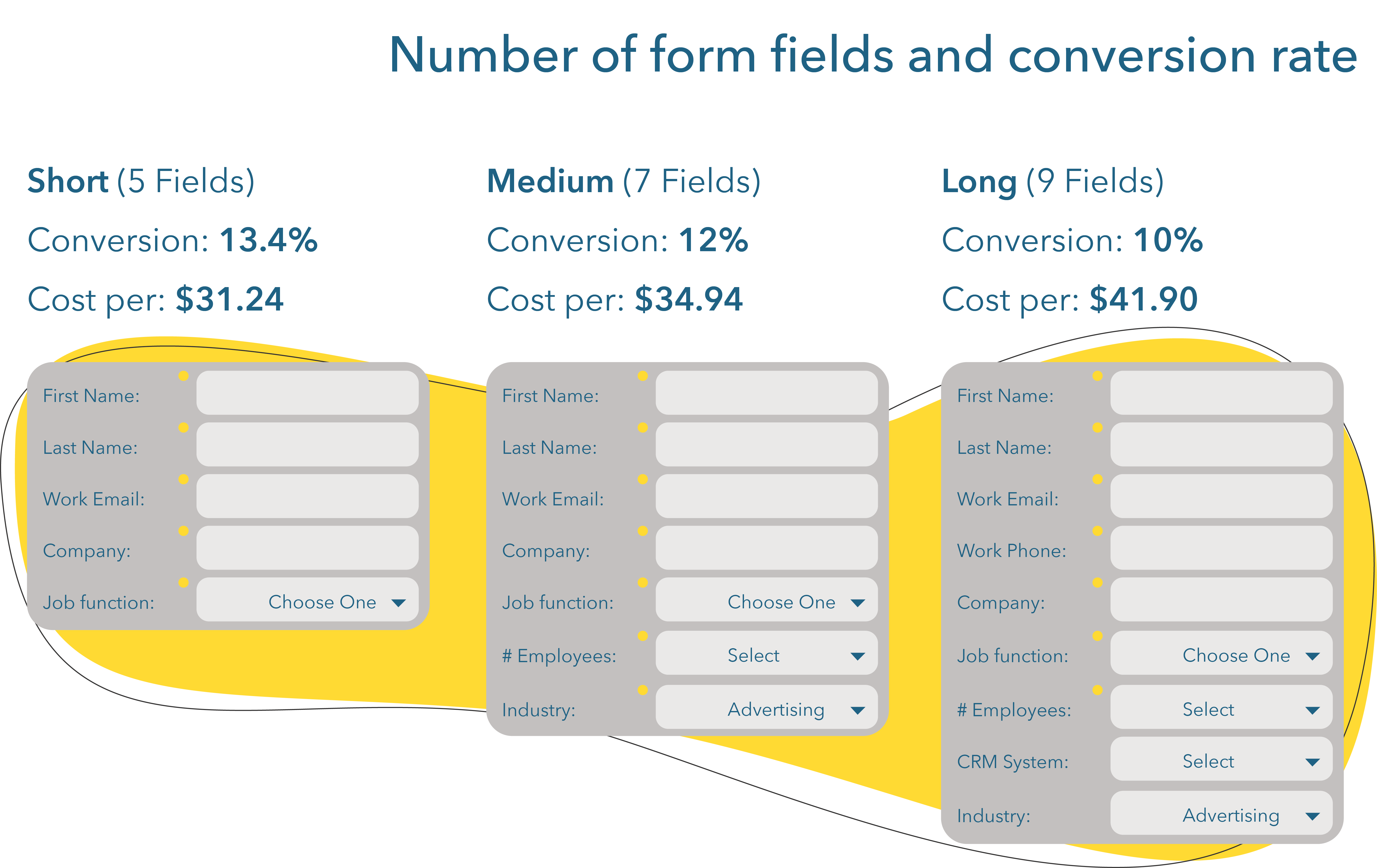
Now, if asked “how many form fields should you use as a firm in a lead generation campaign,” it might be tempting to answer “one.” Clearly, the fewer form fields, the more leads! Yet, fewer form fields also preclude us from getting important information about our potential customers. In the case above, the 5 fields form did not get the number of employees of the firm, the industry they are in, the type of CRM system they use, or their job function. These pieces of information are important because not all email addresses are equal. If, for example, a firm specializes in a specific industry and in companies of a specific size (e.g., SMEs in the fashion industry), then collecting these pieces of information might be worth the additional $3.70 that the lead costs. This is because collecting this information will help qualify leads and will save money in the long run when running a lead nurturing campaign. We discuss this idea in greater detail in lead scoring later in this chapter.
Apart from longer lead generation forms, leads are also often obtained when short opt-in forms are used in concert with ungated content marketing efforts. We see this very often on blogs, for example. See a few examples below:
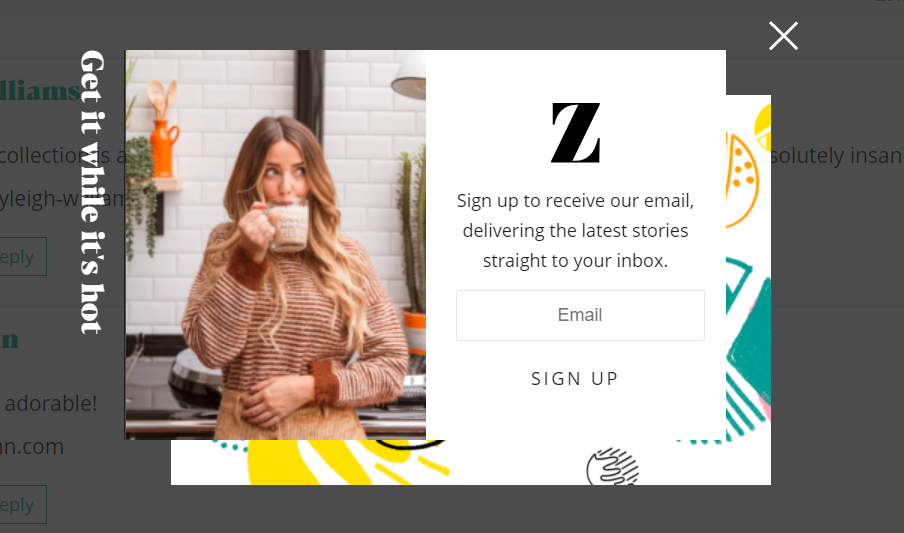
Scroll-down pop-up opt-in on Zoella.co.uk
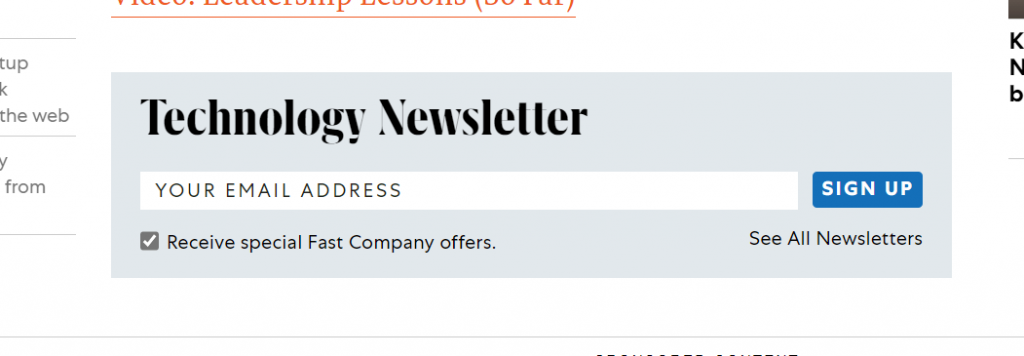
Bottom of content opt-in on fastcompany.com
Lead opt-ins exists in many forms: They can be found in the footer of web pages, in the middle of a blog post, at the bottom of a content page, as a welcome gate (a pop-up at the first start of your web browsing experience on a specific site, such as when you get on Neil Patel’s website for the first time), or lightbox pop-up (overlay boxes that pop up) that appear depending on certain actions (such as a specific amount of time spent on a site, when you scroll to a specific section of a page [such as when you scroll all the way down on Zoella’s blog posts], when you enter a specific page, or when you have viewed a specific number of pages on a website).
Opt-ins can be characterized based on two dimensions: whether consumers explicitly know that giving their email address will enter them in lead nurturing campaigns or not, and whether the opt-in in confirmed by the firm once done or not, as follows (from Marketo’s Definitive Guide to Email Marketing):
- Implicit opt-in: “When a website visitor fills out a form on your site such as to download a content asset or register for a webinar. Your website’s privacy policy must state that performing this action automatically opts the user into email marketing. This option is low effort, but also has the lowest level of engagement.”
- Explicit opt-in: They “require the user to voluntarily sign up and give their persona information. Often this takes the form of a registration box or page that reads something like “I want to receive news and updates.”
- Single opt-in: “When a new subscriber enters his email address and possibly other information (demographics, preferences, etc.). He is immediately subscribed and will automatically receive the next email in your nurture campaign.”
- Double opt-in: “These occur when a new subscriber enters his email address and, depending on your needs, other information and content preferences. A post-subscribe thank you page may alert him to look for an email conformation. Once he receives that email, he’ll need to click on a link or button to confirm.”
Increasingly, transparency has become the name of the game when practicing online marketing, and an explicit, double opt-in is often seen as a best practice. This is because consumers are more likely to open emails that they receive when they clearly know that they had signed up to receive them. Additional, double opt-ins ensure that consumers want to receive an email and that the email address they give is valid.
Lead Scoring
Lead scoring is an approach to rank leads based on their value to a firm, which supports marketing and sales activities. It helps qualify leads and indicate whether efforts should be devoted to market to a lead, as well as the movement of the lead throughout their journey and, potentially, if and when they reach the purchase stage.
Many approaches exist to score leads, such as:
- BANT: Budget, Authority, Need, Timeline
- MEDDIC: Metrics, Economic buyer, Decision criteria, Decision process, Identify pain, Champion
- CHAMP: Challenges, Authority, Money, Priority
- GPCTBA/C&I: Goals, Plans, Challenges, Timeline, Budget, Authority, Negative Consequences and Positive Implications
- ANUM: Authority, Need, Urgency, Money
- FAINT: Funds, Authority, Interest, Need, Timing
Lead scoring approaches use data collected by the firm (e.g., using forms) as well as behavioral data collected during the interactions of leads with the firm (e.g., whether or not the lead opens an email, requests a call, or views a product). We will group these types of data under ‘observable or explicit characteristics’ and ‘behaviors or implicit characteristics.’ Either type of data helps the firm know whether a consumer is interested in you and whether you should devote efforts marketing to them.
Observable or explicit characteristics represent data that a firm can readily collect by asking consumers or observing them (e.g., on their LinkedIn profile). This data is typically collected by asking consumers, for example, by using a form or during a phone call or looking them up online. Examples of such characteristics include:
- Job title
- Firm size
- Personal or firm revenue
- Company size
Marketo offers more than 50 observable/explicit characteristics in their lead scoring guide (p. 18)
Behavioral or implicit characteristics represent data acquire through the tracking of online activities to measure the interest of a lead in a firm’s product or service. This data is typically collected when a lead visits the firm’s website, interacts with its emails, and respond to offers. Examples of such data points include:
- Clicking on a link in an email
- Viewing a product page
- Watching a video demoing a product
- Viewing multiple pages during a session
Marketo offers more than 200 behavioral/implicit characteristics in their lead scoring guide (p. 19-20).
Lead scoring entails first identifying the data that a firm believes is relevant to score leads. This process will greatly vary depending on the firm. Questions such as: who is responsible for making purchases, does my consumers need a certain revenue to buy my product, or what kind of actions can make consumers take that show interest in my product can help identify how to score leads. Once the right characteristics have been identified, firms will typically assign a weight to them. For example, having the right job title might be ‘worth’ less than viewing a product demo or requesting a sales call. It is by assigning points to each characteristic that a firm can establish whether a lead is qualified or not and how a lead is moving in their journey. Leads reading a certain score can be identified as marketing qualified, while leads that reach later a higher score can be identified as sales qualified.
An example of a lead scoring framework that has been heavily used historically by firms throughout the world is the BANT (Budget-Authority-Need-Timeline) framework. We use this framework to exemplify how to perform lead scoring when focusing on observable or explicit characteristics. For example, to create a lead score, a firm could create forms or collect data during calls with potential customers and ask questions such as:
- Budget: What is the budget of the potential customer? How does it align with my product or service?
- Questions to ask the lead:
- Do you have a budget set aside for this purchase? What is it?
- Is this an important enough priority to allocate funds toward?
- What other initiatives are you spending money on?
- Does seasonality affect your funding?
- Questions to ask the lead:
- Authority: Who makes the decision to purchase?
- Questions to ask the lead:
- Whose budget does this purchase come out of?
- Who else will be involved in the purchasing decision?
- How have you made purchasing decisions for products similar to ours in the past?
- What objections to this purchase do you anticipate encountering? How do you think we can best handle them?
- Questions to ask the lead:
- Need: What is the need of the lead? Can my product or service answer this need?
- Questions to ask the lead:
- What challenges are you struggling with?
- What’s the source of that pain, and why do you feel it’s worth spending time on?
- Why hasn’t it been addressed before?
- What do you think could solve this problem? Why?
- Questions to ask the lead:
- Timeline: What is the purchase timeline of the lead? How does this align with my sales process?
- How quickly do you need to solve your problem?
- What else is a priority for you?
- Are you evaluating any other similar products or services?
- Do you have the capacity to implement this product right now?
Last, it is important to emphasize the role of progressive profiling, the idea that you should collect information with potential customers throughout their interactions with your firm. As we saw earlier, you cannot ask a lot from visitors when they fill out a form without hindering the conversion of visitors to leads. How do you then collect this information? By slowly collecting bits and pieces over time. This can be done, for example, through the use of progressive profiling technologyand dynamic forms, where a firm sets up ahead of time many forms that iteratively collect information based on what a consumer will have provided on a previous form. Put differently, if consumers give their name and email in the first form, the second form will move to ask pieces of information that have yet to be obtained. Another approach is to combine explicit and implicit scoring and score a lead over time as they interact with a firm’s website.
Lead Nurturing
Once a firm has acquired leads and qualified them (i.e., marketing qualified leads), it enters in a process of lead nurturing. Lead nurturing represents the “purposeful process of engaging a defined target group by providing relevant information at each stage of the buyer’s journey, positioning your company as the best (and safest) choice to enable them to achieve their objectives” (Hubspot).
Let’s examine some of the key aspects of this definition. First, lead nurturing is a purposeful process. In this chapter and the next, we are going to emphasize how this intent translates in always having a clear idea of ‘what comes next’ for the consumer. What happens when you receive an email address from a consumer? What comes next? What email should you send them? What should be in this email? What action should they be asked to perform then? What should the lead be achieving there? This ties closely to the idea of having clearly defined conversion paths. When doing lead nurturing, the firm is interacting with the lead, but it has a clear script in mind. It knows the steps the lead should go through so that they are converted into customers.
Second, lead nurturing looks at engaging a defined target group. That has a few implications. First, a firm should have clearly defined personas that they want to engage. Second, lead nurturing campaigns are persona-specific. They are persona specific because what might make a persona tick will probably vary between personas. They are also specific because of the third aspect of the definition.
Third, lead nurturing aims at providing relevant information at each stage of the buyer’s journey. The only way to achieve this, i.e., creating relevant content for leads that varies depending on the stage they are at in their journey, is to have a clear persona and a clear understanding of their journey.
Last, firms practice lead nurturing in order to sell products. Yet, as we have seen over the course of the chapters, this should ideally come at the end of the lead nurturing process, i.e., when the firm believes that the lead has reached the purchase stage.
Four main activities relate to lead nurturing:
- Get permission to market to consumers, or what we achieve during lead generation
- Educate and entertain leads with relevant information that aligns with their stage in their journey
- Monitor the progress of leads through lead scoring
- Promote your product once the lead has reached the purchase stage
On average, consumers who provided you with their email addresses receive ten marketing touches from the time they enter the top of the sales funnel until they become a customer.
To facilitate segmentation for lead nurturing activities, firms typically create extensive email marketing lists. These lists should provide the information necessary to create campaigns that correctly address the needs, challenges, and motivations of consumers and the stage of the journey they are. Useful information to include in such lists could be:
- Socio-demographic information, which facilitates targeting activities
- Acquisition date, which helps to know whether the lead aligns with how long it typically takes a firm to sell a product to that specific persona
- Frequency: How often the lead has indicated they would like to receive emails
- Lead score & assumed journey stage: This should help tailor which email to send to which lead depending on their stage in the journey
- How/Where did you acquire them: This is helpful to continue the conversation a firm started with a consumer. For example, let’s assume that a consumer signed up to an email list from a blog post or a pillar page on the topic of ‘back pain’ from the website of a shoe manufacturer specialized in back pain. Ideally, this consumer should receive information that is different from another consumer who signed up after clicking a search ad that offered ‘comfortable shoes.’ The more information a firm provides to leads that caters well to their needs, motivations, and challenges, the more likely they are to engage in a conversation and ultimately buy a product.
- Persona: This, similar to above, helps tailor the message
The main idea here is that one size does not fit all. Lead nurturing campaigns should be clearly tailored to personas and the stages they are in.
To analyze marketing campaigns, metrics exist such as:
- Bounce rate: The number of email addresses that had a bounce back from the ISPs
- Open rate: The percentage of emails opened out of the total number of emails sent.
- Clickthrough rate: The number of subscribers that have clicked on at least one link in your email
- Click to open rate percentage (CTO): the percentage of recipients who opened the email message and also clicked on any link in the email message.
- Unsubscribe rate: The percentage of subscribers who opted out from your list (Unsubscribed number/Emails delivered x 100 = Unsubscribed rate %)
These metrics should help gauge the level of engagement of leads with our email marketing campaigns, and where there might be issues. For example, if our open rate is great but our clickthrough rate is abysmal, this probably indicates that there is something wrong with the way the email is crafted, or that the content does not align with the subject title of the email.
What Happens Once You Get a Lead?
Ideally, getting an email address should start a sequence of pre-planned emails and other marketing activities (such as ad retargeting, which we will cover in the next chapter). This sequence of pre-planned emails should aim at transforming a marketing qualified lead to a sales qualified lead (MQL to SQL), using targeted content to move the lead from informing them about their problem to helping them evaluate their solution to explain why a firm’s product is the best solution.
The first email in an email marketing campaign should be an onboarding email. An onboarding email should guide leads and educate them about what is about to come. They should help make a lead takes the next step in the series of pre-planned activities a firm has sequenced. Often, onboarding emails will tell leads what to expect, such as the content of future emails and how often they will be sent.
Let’s take a look at Instagram’s onboarding email.
First, Instagram asks whether we indeed create an account with them, i.e., they practice double opt-in.
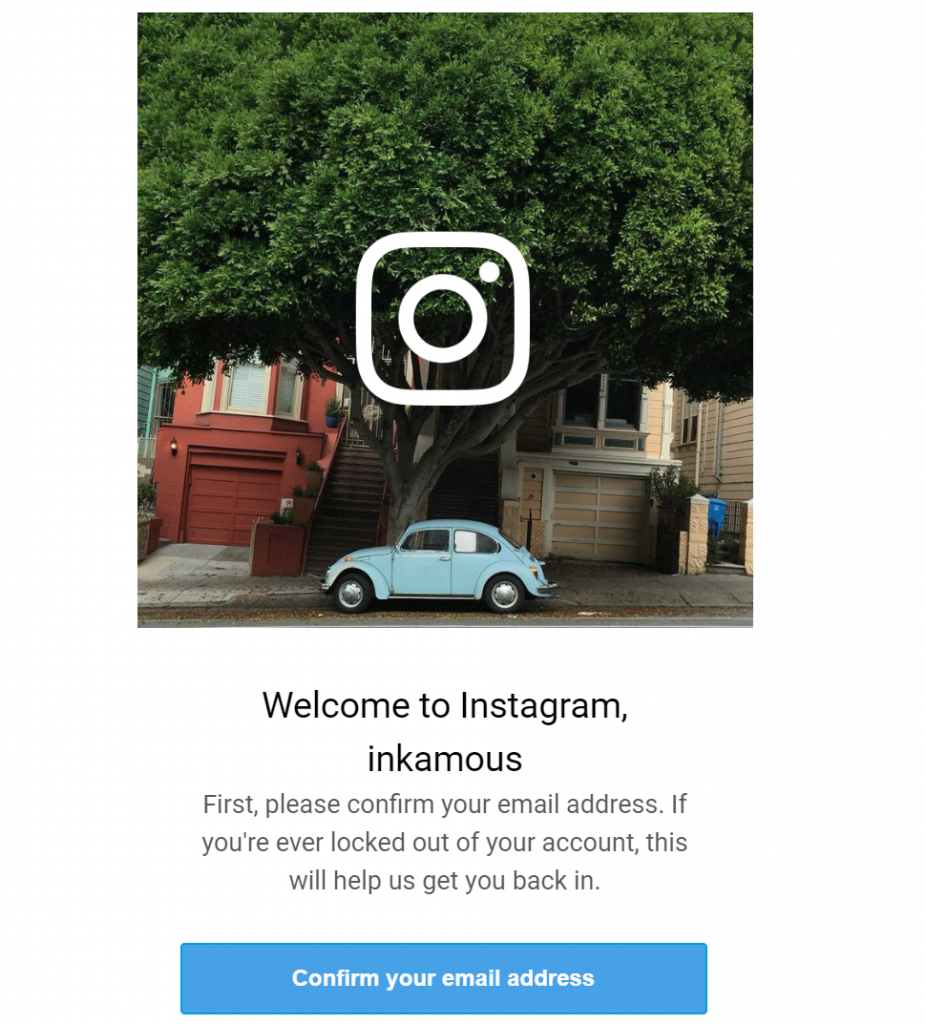
Second, they push you to take the next step in order to maximize your engagement on their platform. In the case of social media networks, a threshold effect has been found to maximize engagement, where following a minimum number of people greatly boosts the chances of users coming back. It thus makes sense for this to be the first action that Instagram proposes users to engage in.
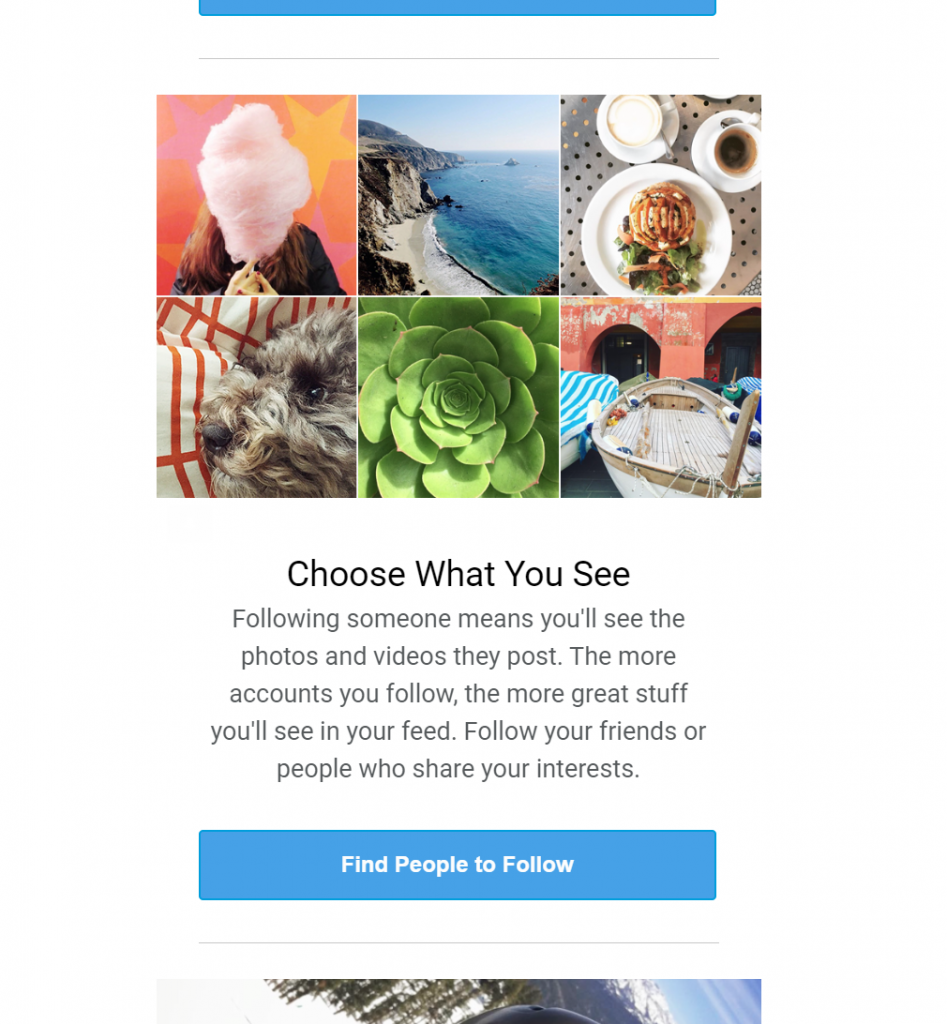
Last, Instagram offers users to start using the product, which is also quite well-aligned with what we would expect people to want to do once they have signed up for an Instagram account.
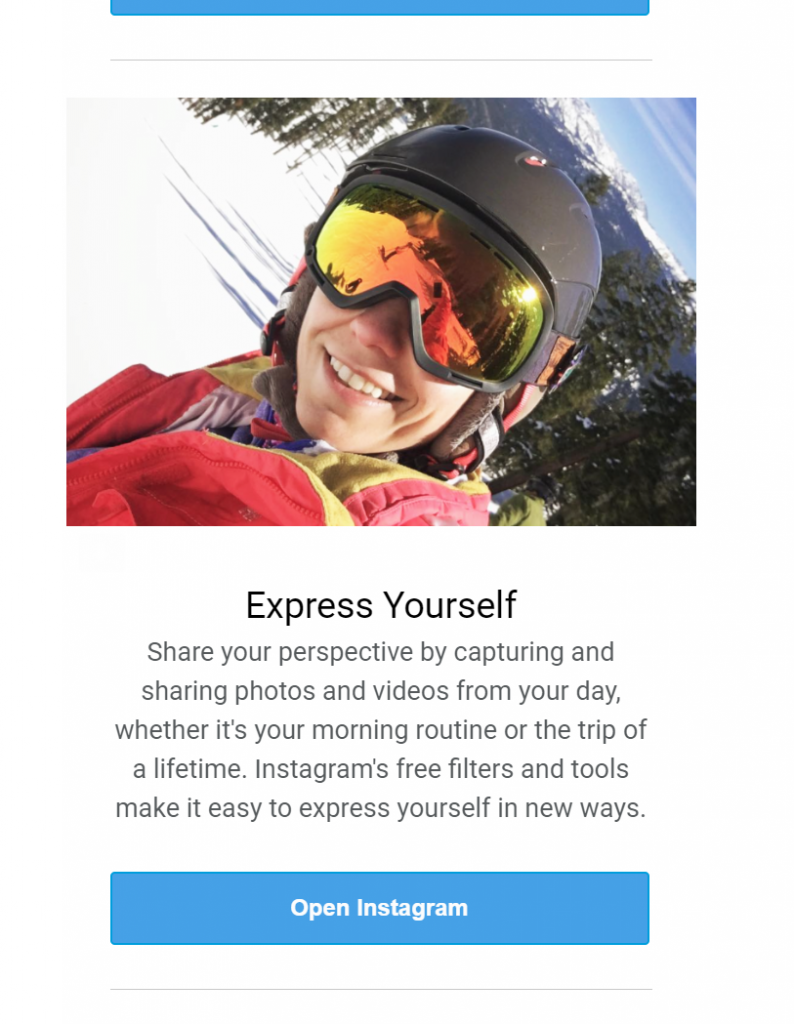
Here is another example, this time from a lead obtained from a content opt-in newsletter subscriber who was reading a blog article on Christmas decorations on the Crate & Barrel blog. Importantly, we can see how Crate & Barrel continues the conversation that started on a Christmas-related blog post by offering more information on Christmas decorations.

First, the onboarding email congratulates the lead for signing up for the newsletter and explains what the lead should be receiving in the future. Then, the first action offered to consumers is to explore the new articles relating to Christmas decorations. The email then breaks down product categories that a user might be interested in.
The onboarding email should be the first email in a sequence of emails meant to convert leads to customers, which should ideally follow consumers in their journey (i.e., moving from problem to solution to product). This email sequence is often referred to as a drip email sequence or drip email campaign. Here is how Hubspot explains a email drip campaign:
An email drip campaign is a form of automated sales outreach. It’s comprised of a series of emails automatically sent to a specific audience after they take a specific action. For example, if a lead downloads a whitepaper on recruiting best practices, they might be placed in a drip campaign sharing relevant recruiting content. The final email might include a CTA to request a demo for your recruiting software.
This is (very simply) represented in the figure below. The exact steps and content would depend on the stage at which a consumer signed up. For example, were they reading an awareness post or reading about potential solutions for their problem?

We can see how each email serves a dedicated function. The first email is an onboarding email explaining the value of signing up for the newsletter. The following email could be a problem or solution-focused email depending on where the consumer is in their journey (Since we are at the lead generation stage, generally the consumer should be further down the funnel, e.g., weighting their options). The third email is a promotional product email to conclude a sale, the fourth email is a reminder (if the sale hasn’t been concluded), and the last email makes sure that the consumer still wants to receive emails (since the sale still hasn’t been concluded).
A simplified application of this sequence is provided by dripscripts below:
- Email 1: Bryan, All I can say is THANK YOU! (Thank you email)
- Email 2: Content w/ P.S. Mention of offer (Content email)
- Email 3: Did you get your Cup of Joe? (Promo email)
- Email 4: 1 DAY LEFT) Does anyone else have these questions? (Q&A persuasion email)
- Email 5: [Disappears @ Midnight] 80% off my new Self Publishing Course (…plus 5 free
- bonuses) (Promo email)
- Email 6: LAST CALL – Self-Publishing Training Bundle Closing in 4 hours (Closing email)
Real-life, though, is not as straightforward. Based on what we learned in lead scoring, we could also leverage here the idea of behavioral scoring and create decision trees to help strengthen our chances to convert leads. Did they open the email? Click on the link we provided? Read the blog post? Emails and other marketing activities should be informed by what the consumer has done with the last activity they interacted with. Marketing automation has helped create more complex marketing campaigns based on how a user will have interacted with a previous marketing activity. Here’s a simple example from Jacobs Levenger / Smart Insights:
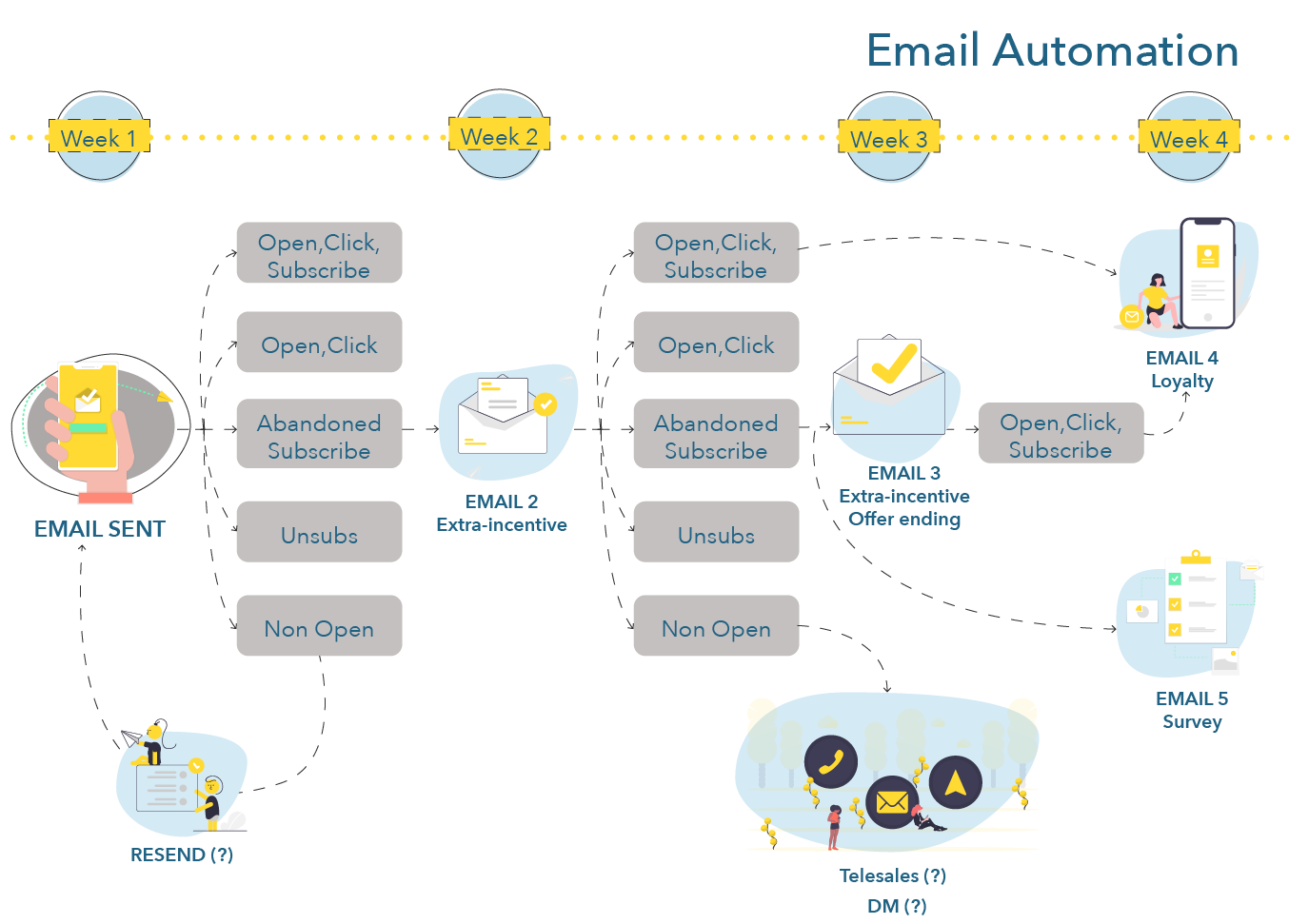
A Few Tips for Writing Emails
The information should be well-hierarchized, with the main message and the call-to-action associated with the goal you want consumers to accomplish should be located above the fold (i.e., before any scrolling happens). Emails should be short, with little to no scrolling. The subject line should include a call to action and be transparent about the content of the email. Emails aiming at conversion with a clear goal for consumers after the click can benefit from being associated with a landing page (i.e., the click leads the user to a landing page), and other landing pages tips, such as maintaining a low attention-ration, can be useful to create highly-converting emails. Mailchimp provides its top tips and advice as well as design ideas in their email design guide here.
You are Paperlike, a company that specializes in an iPad screen protector that replicates the paper experience
One of the personas you are targeting is Alister and Alice:
- A&As are illustrators eagerly awaiting their new iPad Air 2020, with the Pencil 2. They intend to use the Procreate app to start doing digital drawings and designs. They are new to illustrating in a digital environment and they have never used a device like this to draw before. They are reticent to move away from pen and paper, but believe that this might help move their work online more easily.
Scoring leads
- What are two different marketing activities you could do to gather leads?
- You are creating a form associated with a piece of gated content. How would you score potential leads?
- What would be the first 3 questions you would ask?
- What would be an additional 2 questions?
- What could be a few ways to score leads behaviorally (i.e., based on implicit characteristics)?
Email campaigns
You have created leads with A&As using a bottom-of-content opt-in. The blog post was problem-oriented. The title of the post was ‘Becoming a digital artist,’ and it addresses some of the problems illustrators face when moving to a digital environment.
- •Think a series of 5 emails
- What will be the general idea of each email?
- How can you score the lead behaviorally?
- How do you nurture the lead towards a sale?

